Front porch roofs do far more than keep rain off the welcome mat—they frame first impressions, extend living space, and can even lower energy bills when sized and vented correctly. Industry guides note that upgrading a porch cover is one of the simplest ways to boost curb appeal and resale value, while design magazines rank a well-planned entry canopy among the top outdoor investments for 2025. Below, you’ll find twenty distinctive front porch roof ideas—each paired with practical tips—so you can match structure, climate, and style with confidence.
1. Classic Gable Porch Roof

A classic gable front porch roof instantly signals timeless charm while relying on straightforward framing that most contractors can tackle without major engineering. Because the ridge runs perpendicular to the house, rain and snow slide cleanly off both slopes, reducing ice-dam risk and long-term shingle wear. Ventable soffits at the eaves pull fresh air up to the ridge, keeping attic temperatures and humidity in check on blazing summer days. Align the gable’s pitch with—or one step lower than—the main roof so the addition feels intentional, then finish the underside with tongue-and-groove boards and a fan box to create a breezy, bug-free sitting zone.
2. Sleek Shed Porch Roof
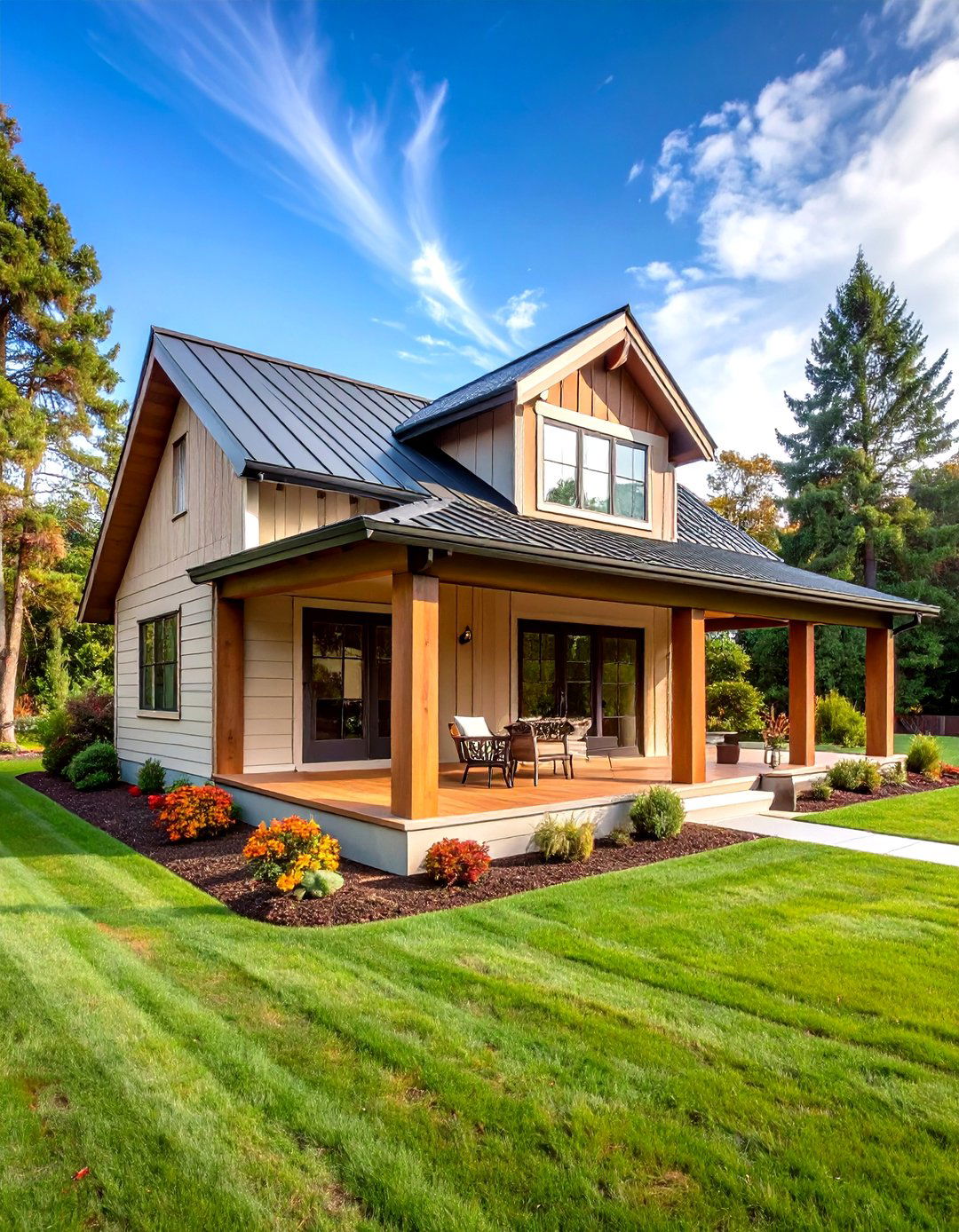
Unlike the gable, a sleek shed front porch roof uses a single slope that tucks neatly below second-story windows—perfect for ranches or modern farmhouses where you don’t want to block natural light. Bob Vila’s designers praise shed roofs for their quick installation and economical lumber cuts, since rafters are all identical lengths. Keep the high wall flashing tall and properly counter-flashed, and angle the roof no less than 3-in-12 so water runs clear. Consider standing seam panels or long-life architectural shingles in a contrasting color to highlight the minimalist line and visually “stretch” a narrow façade.
3. Hip-Style Porch Roof

As storms intensify, many homeowners choose a hip front porch roof for its aerodynamic stability: four sloping planes meet at a central ridge, bracing against uplift and high lateral winds better than open gables. The design does cost extra framing lumber, but insurers in hurricane zones sometimes reward the shape with premium discounts, offsetting the up-front spend. Keep pitches moderate (4- to 6-in-12) to shed snow while preserving headroom, and anchor the outer corners with tapered columns or stone piers that echo the roof’s low, sheltering profile.
4. Standing Seam Metal Porch Roof
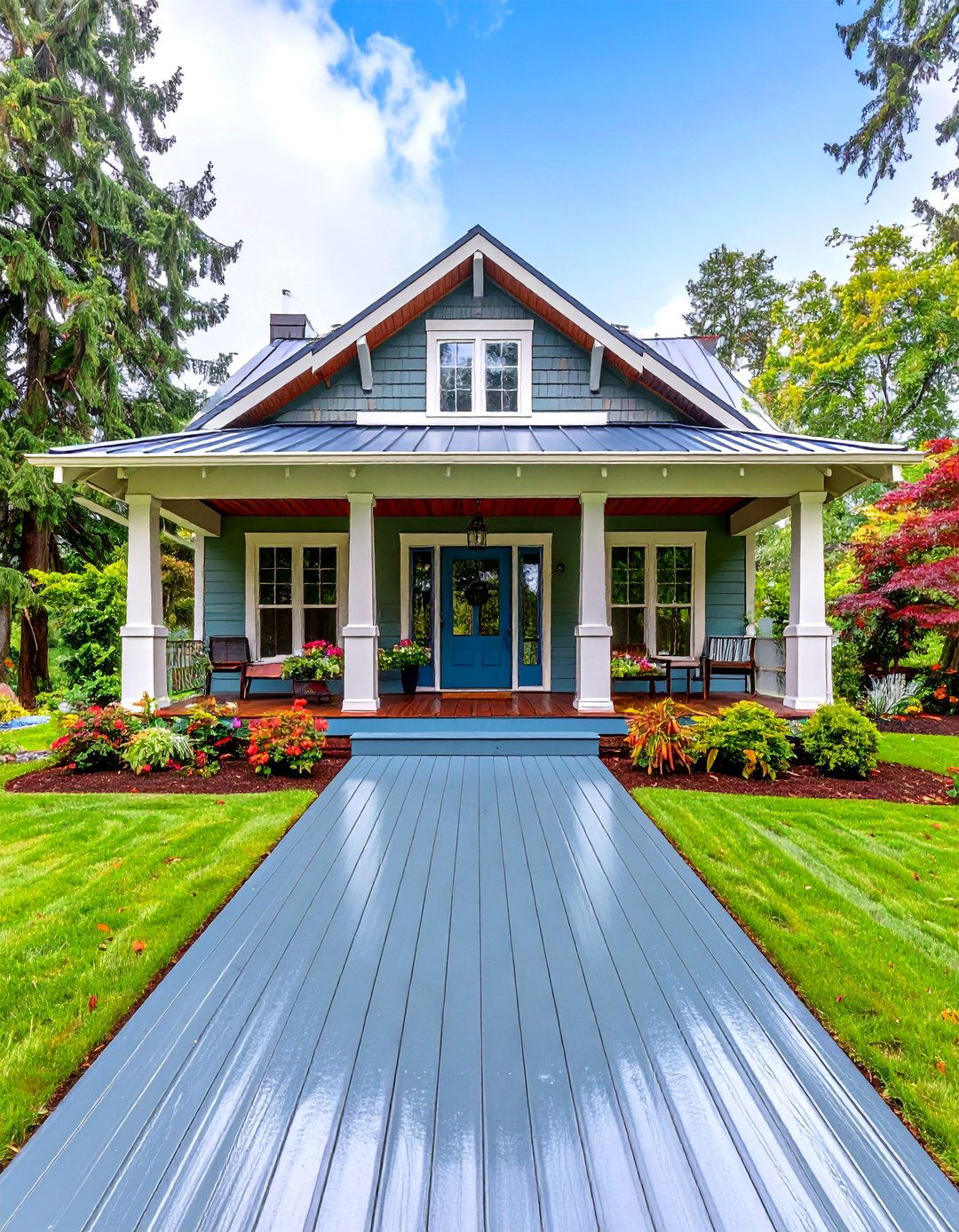
To inject modern shine and decades-long durability, swap shingles for a standing seam metal front porch roof. Premium aluminum or steel panels last 40–70 years and shrug off 140 mph winds, making them a true “install-once” upgrade. Use hidden fastener clips to allow thermal movement, and specify a high-reflectance coating if your entry bakes in direct sun. Dark charcoal or matte black instantly updates colonial façades, while soft zinc gray blends with coastal cottages. Tie gutters into rain chains to celebrate the clean vertical seams rather than hiding them behind bulky K-style troughs.
5. Light-Loving Glass Porch Roof
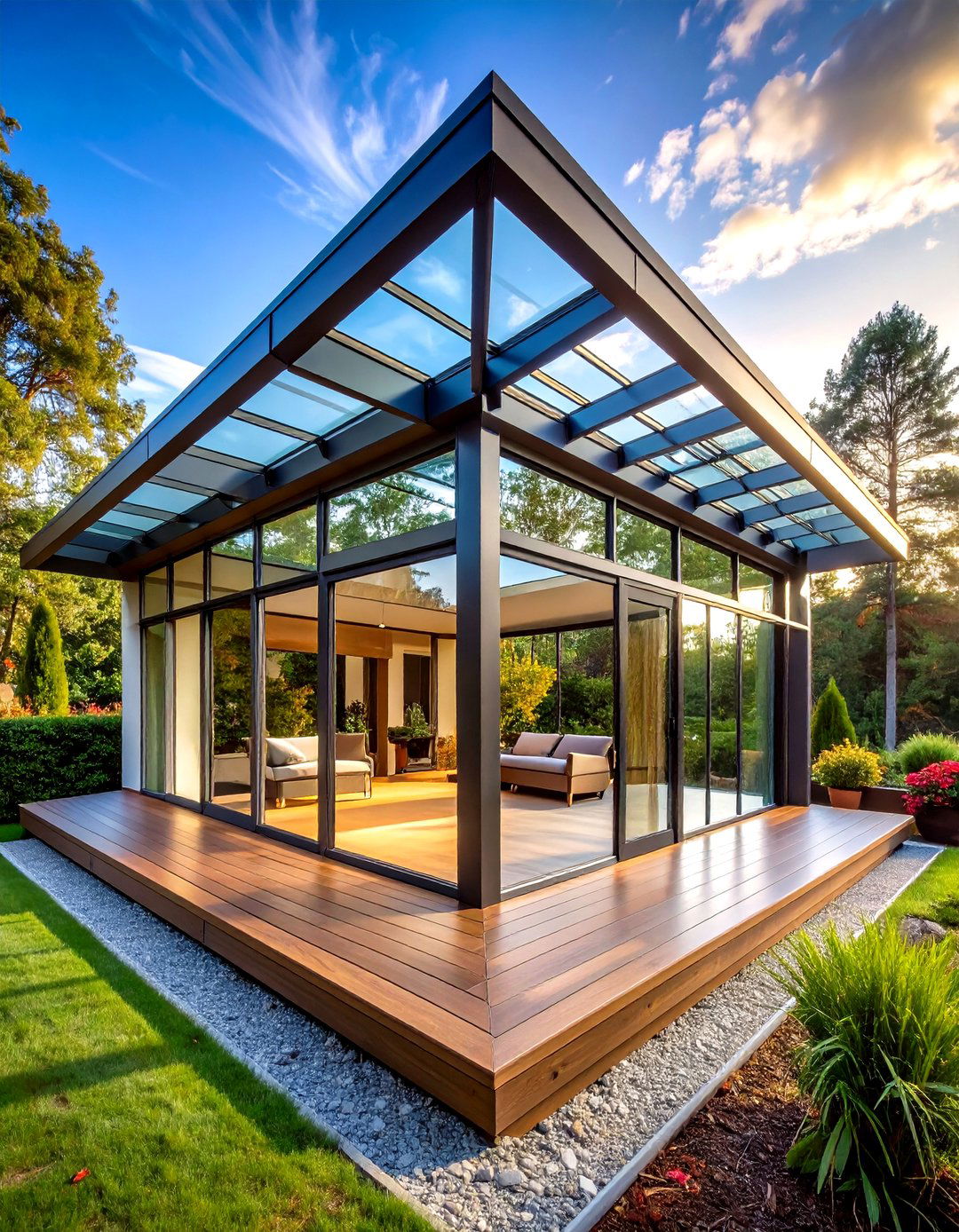
Consider a light-loving glass front porch roof if mature trees or deep eaves keep your foyer dim. Tempered panels admit daylight yet block UV with modern coatings, and sleek aluminum rafters keep sightlines airy. Plan for heat buildup: a low-emissivity (low-E) layer and operable ridge vents will vent rising air, while retractable interior shades tame glare on blistering afternoons. Position downspouts away from walkways; heavy downpours can drum loudly on glass, so rubber isolators between rafters and purlins soften the soundtrack without muting the rain’s relaxing rhythm completely.
6. Pergola-Hybrid Porch Roof
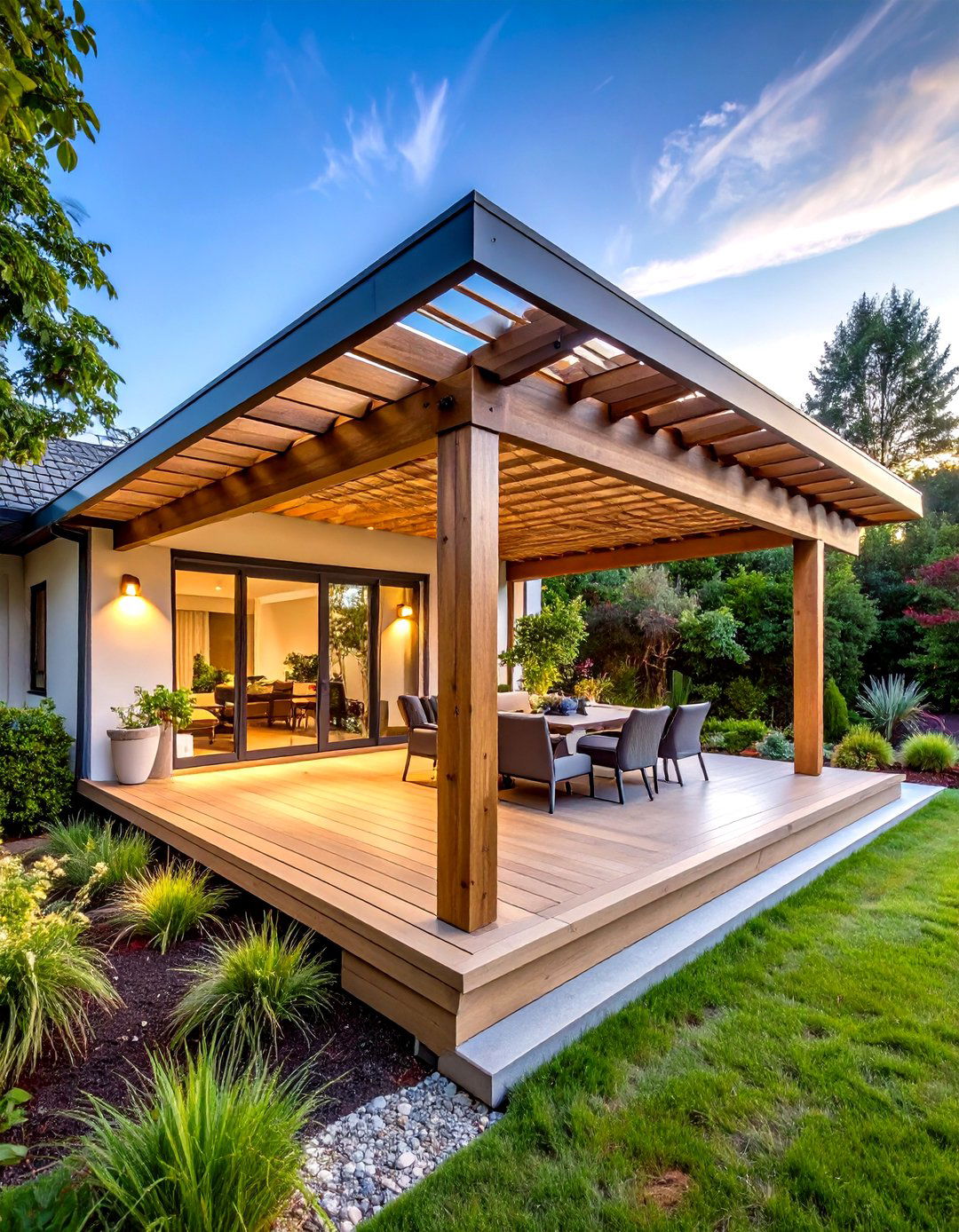
With outdoor “rooms” surging in popularity, a pergola-hybrid front porch roof marries filtered shade and full coverage. Fixed slats or louvers span a beefy timber frame, and a concealed polycarbonate sheet above the slats keeps drizzle off the deck without blocking breezes. Stain the beams to match shutters, then run low-voltage string lights through the rafters for café flair. If winter snow loads are heavy in your area, specify 2×8 or 2×10 rafters spaced 12 inches on-center and a minimum 1-in-12 pitch to shed meltwater.
7. Eco-Friendly Green Porch Roof
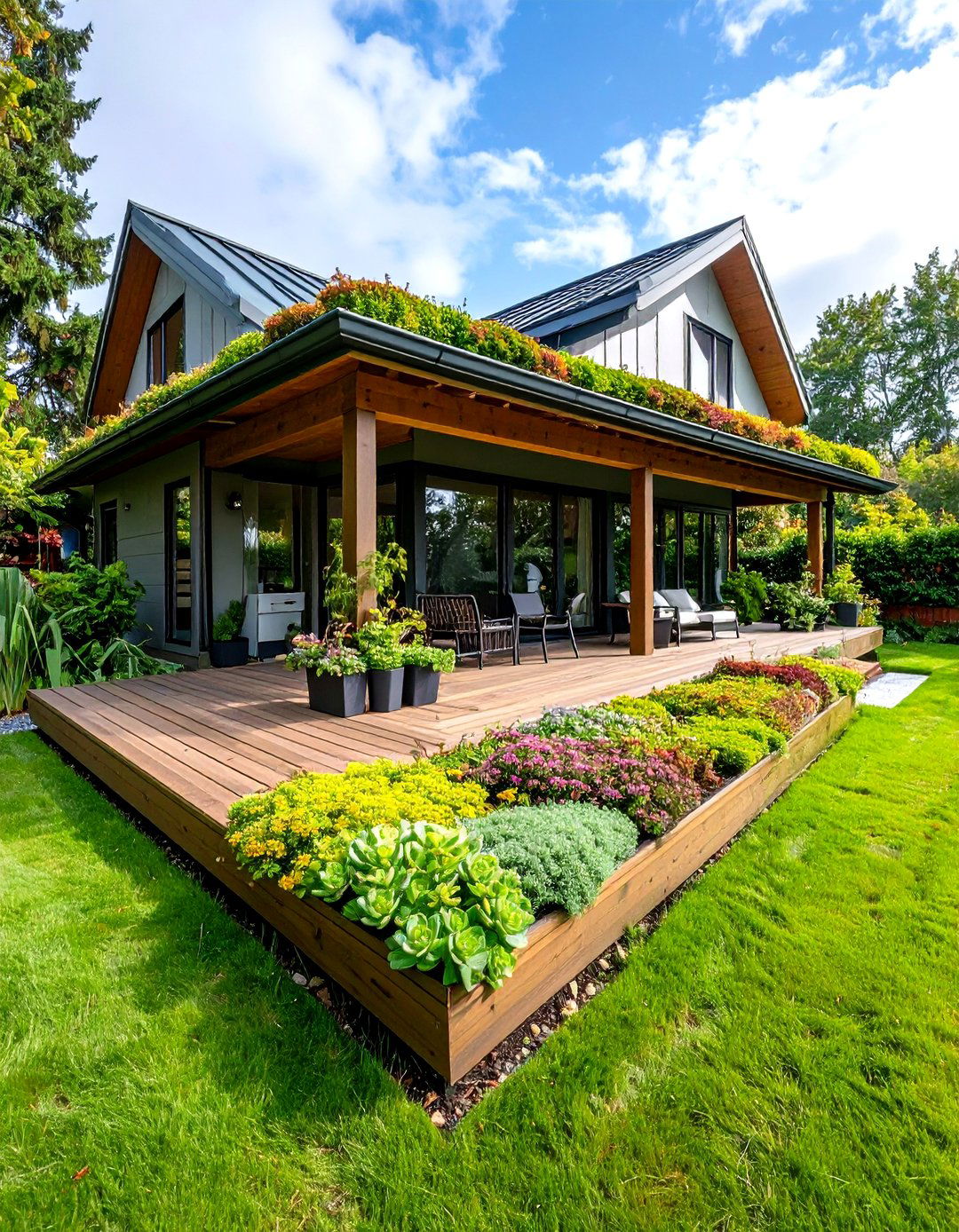
Looking for sustainability? An eco-friendly green front porch roof layers soil and sedum over a waterproof membrane, cooling the entry and absorbing stormwater. Even small-scale kits add habitat for pollinators and boost insulation R-values. Keep live loads in mind: a fully saturated extensive green roof can weigh 15–20 lbs per sq. ft., so retrofit rafters may need sistered LVLs. Edge the planter tray with 6-inch parapets clad in the same siding as the house for a seamless look, and add a drip-edge gravel strip to discourage weeds at the perimeter.
8. Gambrel-Inspired Porch Roof
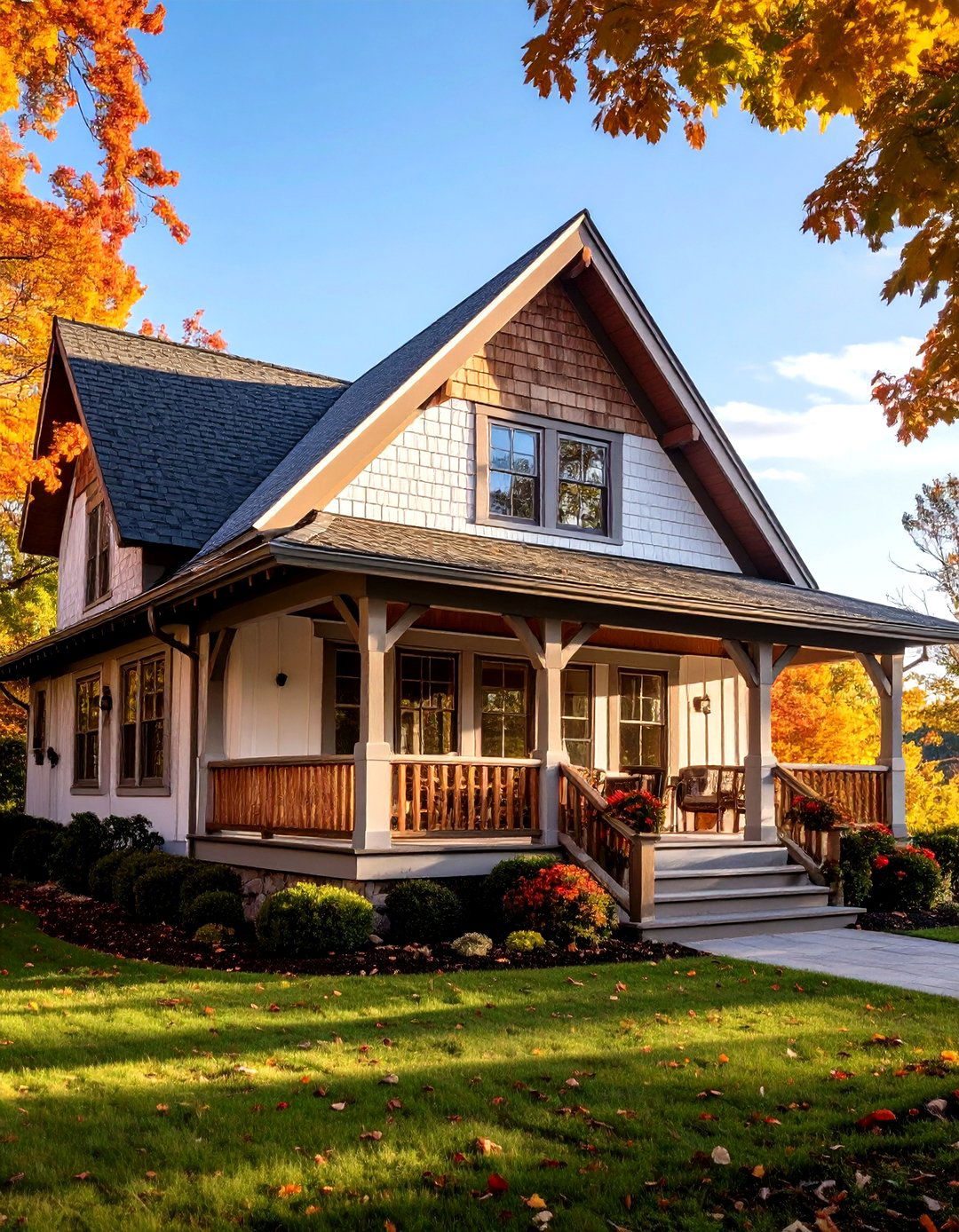
Another volume-boosting option is a gambrel front porch roof—think “mini-barn” with two distinct pitches. The near-vertical lower slope maximizes head clearance, perfect for suspending a porch swing, while the upper shallow slope aligns to the main ridge in classic farmhouse fashion. Use decorative half-timbering between slope changes to echo Dutch-colonial styling, or leave the break crisp for a contemporary twist. Because gambrels collect less snow on the upper angle, they’re handy in regions that see heavy drifts yet still crave vintage charisma.
9. Curved Victorian Porch Roof
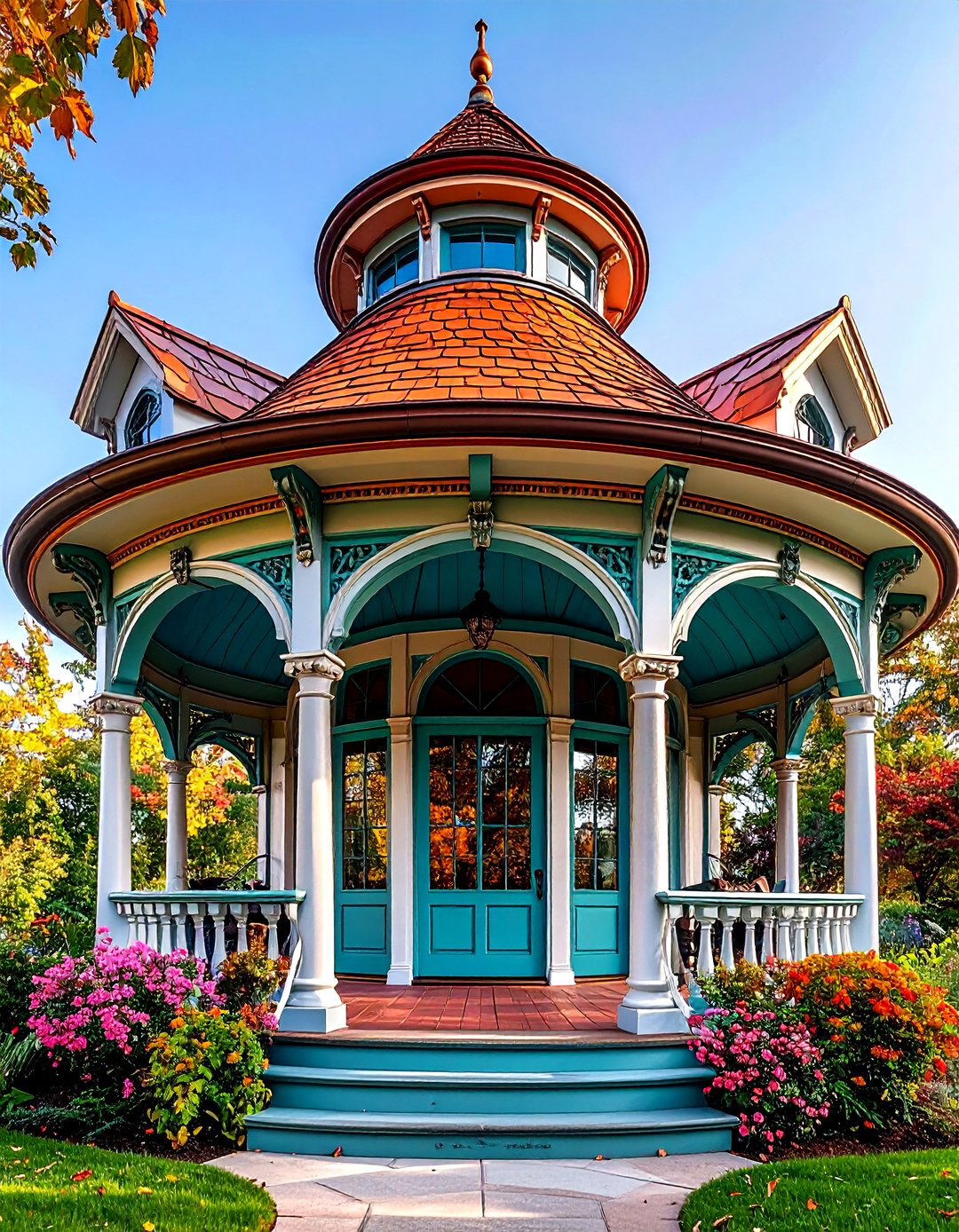
For historic curb appeal, a curved Victorian front porch roof bows gently over the entry and pairs beautifully with spindle columns and gingerbread brackets. Bending laminated cedar or mahogany strips over a plywood form produces a smooth barrel, while copper or terne-coat stainless shingles patinate into postcard texture. Keep guttering minimal—half-round copper held by cast brass hangers follows the arc without visually chopping it. Inside the curve, tongue-and-groove beadboard painted sky blue wards off wasps and brightens the shadow line.
10. Craftsman Exposed-Rafter Porch Roof
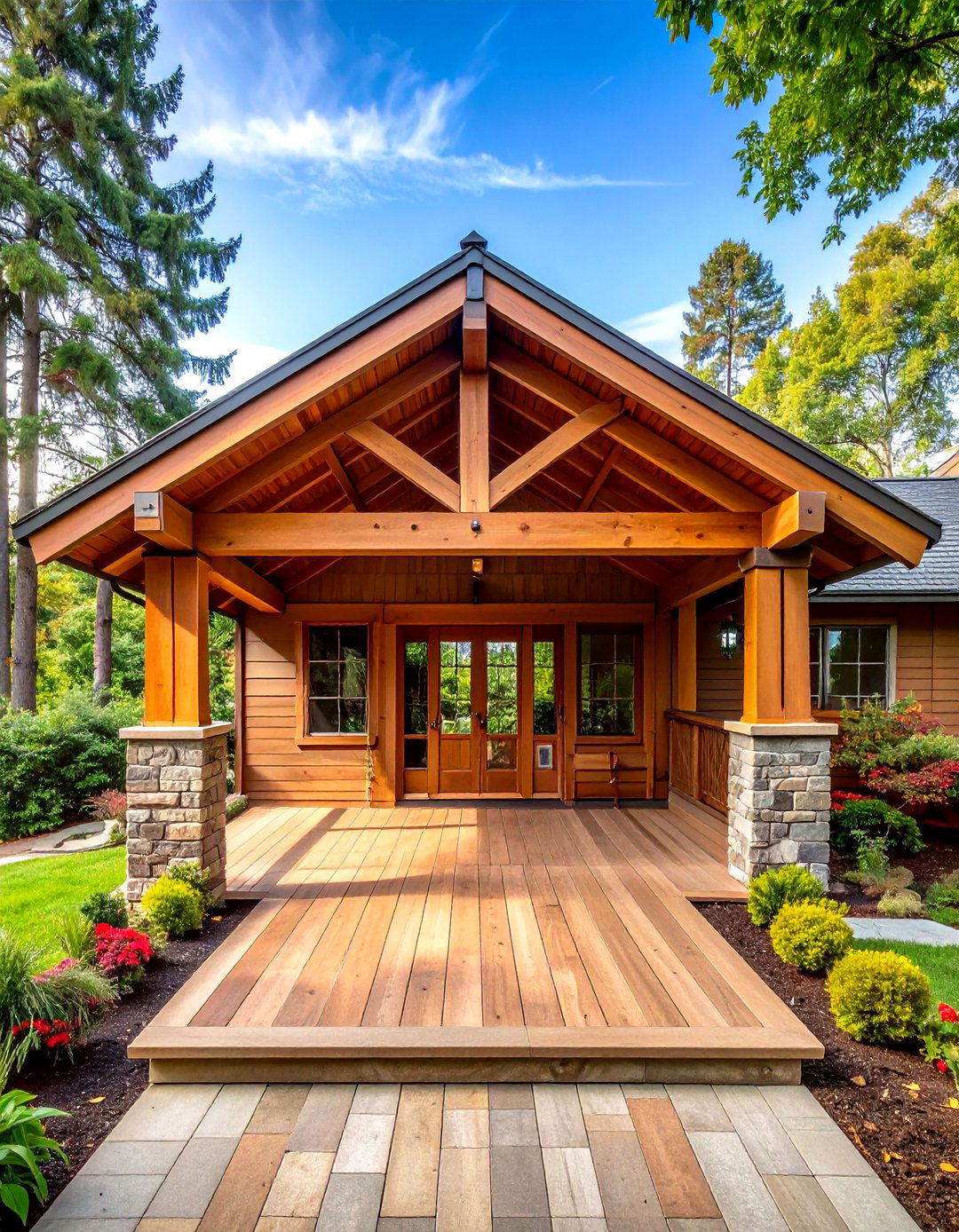
Craftsman devotees can celebrate structure with an exposed-rafter front porch roof. Leaving the tails visible under open eaves showcases joinery and adds depth under modest low-pitch planes. Spec the rafters in beefy Douglas-fir, notch decorative “tails,” and tuck a 2× material ledger under each to hide wiring for pendant lanterns. A muted earth-tone shingle or matte-green metal complements the style’s nature-inspired palette while emphasizing the rhythmic shadow lines the roof casts at sunset.
11. Mid-Century Butterfly Porch Roof
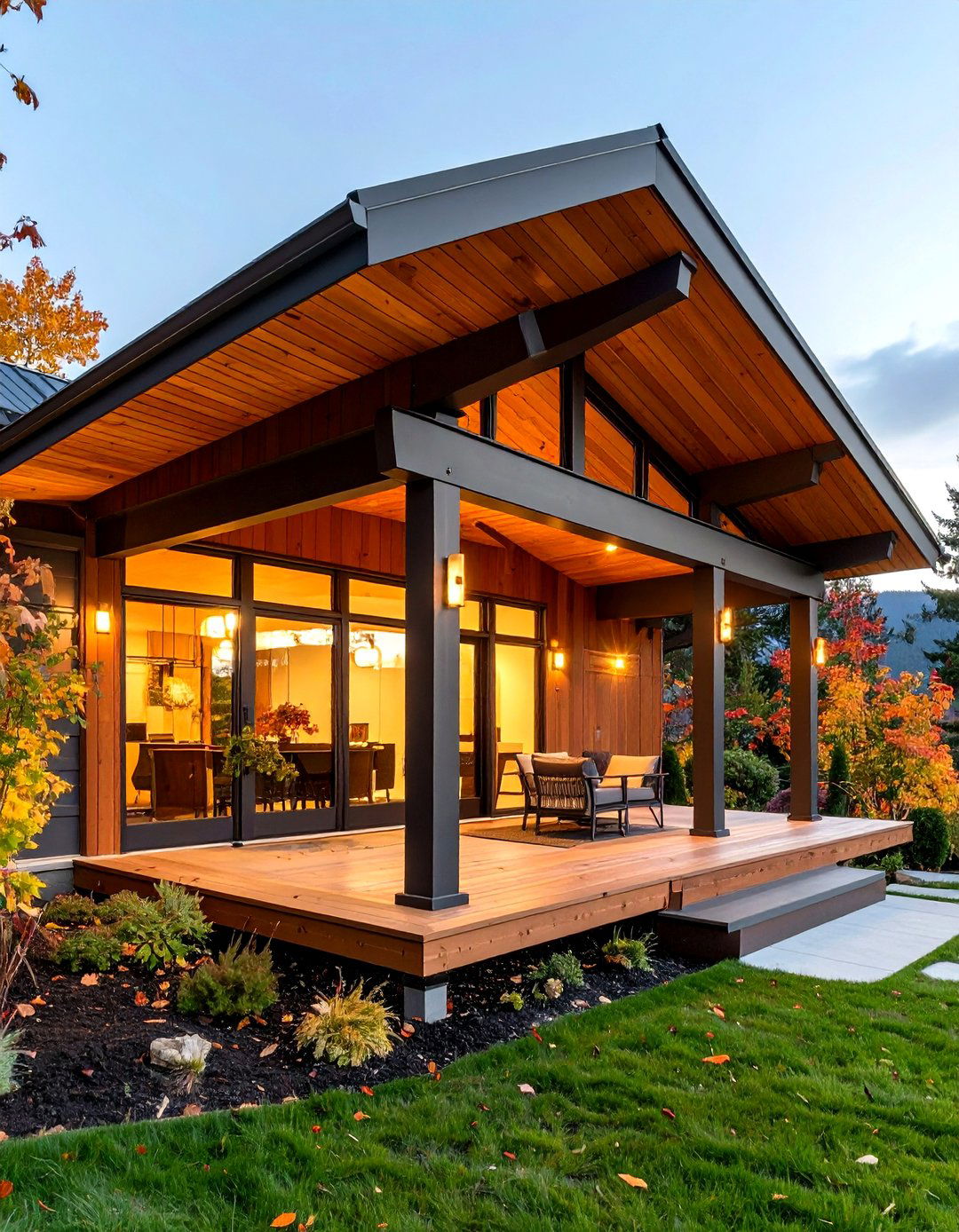
Mid-century aficionados may favor a butterfly front porch roof: two opposing shed planes slant toward a center valley, creating dramatic clerestory opportunities at the outer edges. The inward slope collects rainwater for a slim scupper or concealed downspout—great for rain-barrel irrigation. Keep valley flashing hefty, and angle interior ceiling boards to echo the V-shape, drawing the eye upward. Thin steel posts or concealed knife-plates maintain the hovering look without bulky columns.
12. Modern Cantilever Porch Roof
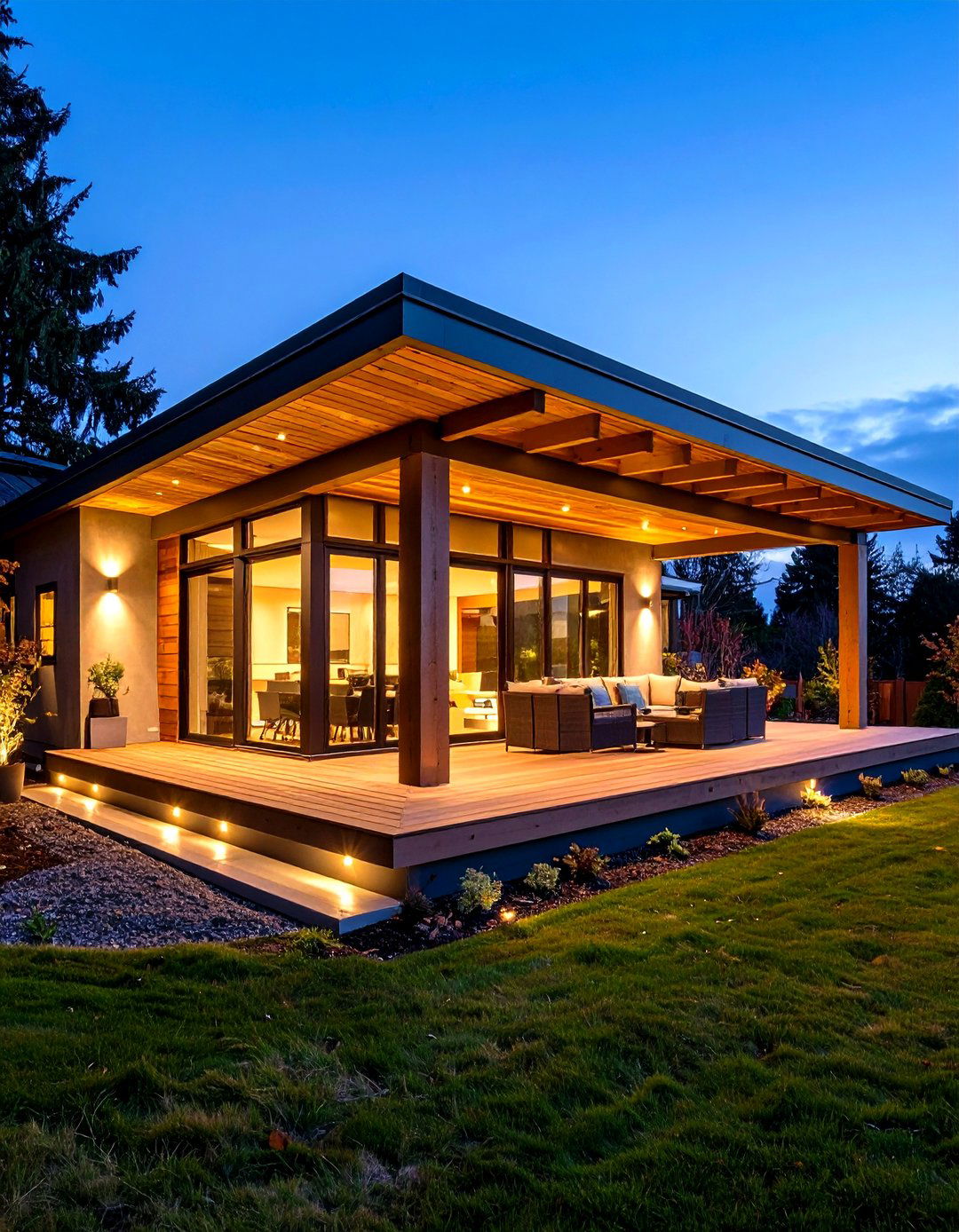
A modern cantilever front porch roof projects boldly from the façade with no posts to clutter the landing—ideal where steps are tight. Houzz galleries show cantilevers up to six feet deep using concealed steel I-beams buried in the ceiling joists. Combine the overhang with fiber-cement soffits, and slot recessed LEDs along the beam line for invisible night lighting. Because wind-lift can be intense on unsupported edges, grade-8 lag screws or welded brackets must tie back into wall studs or a hidden steel moment frame.
13. Gable-and-Shed Combo Porch Roof
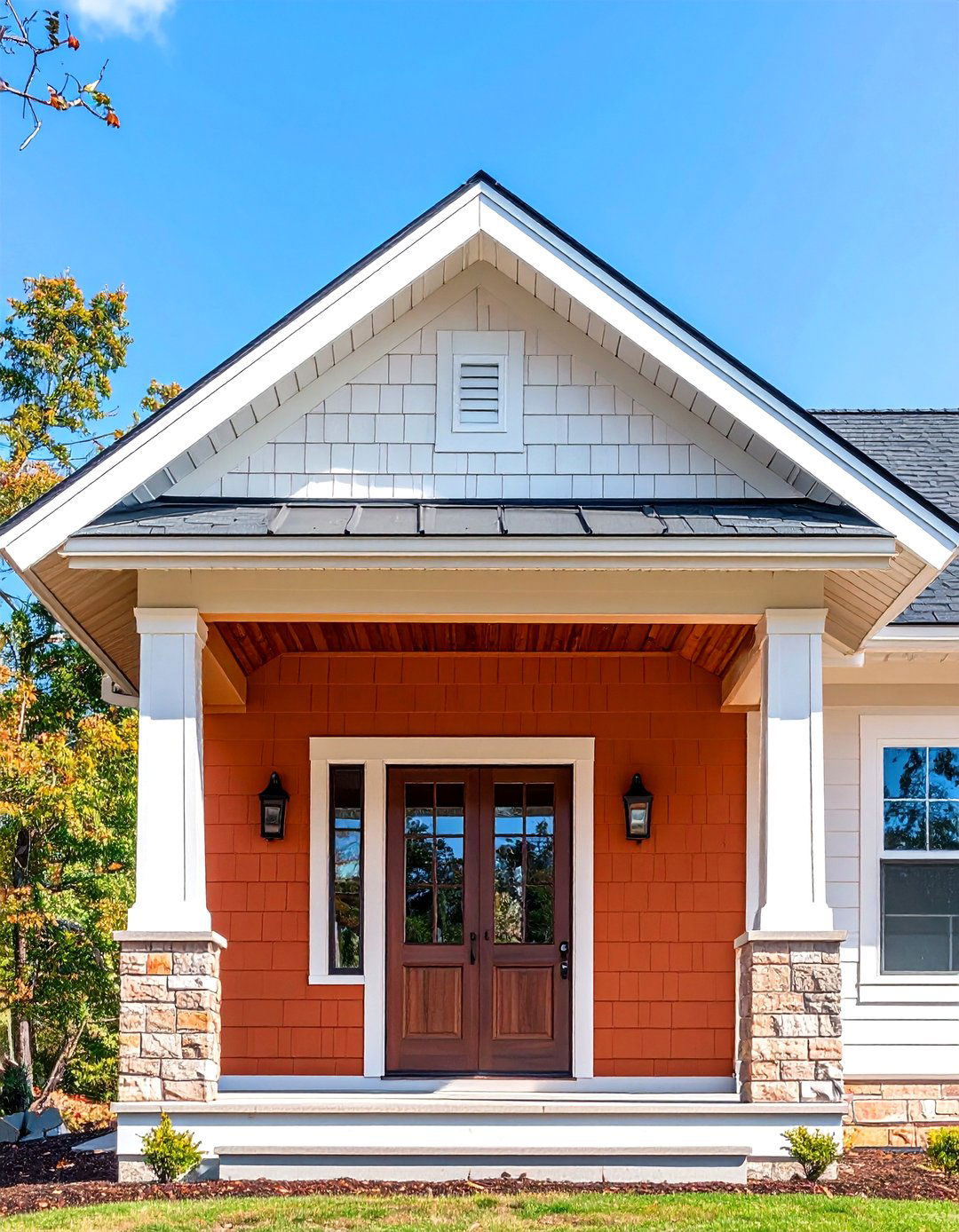
If your façade feels too symmetrical, a gable-and-shed combo front porch roof adds asymmetry and covers tricky bump-outs. One side receives a mini gable above the door for height, while the remainder sweeps into a lower shed that shelters benches or planters. Bob Vila calls the mix a “best of both worlds” solution that balances cost and interest. Flash the joint where the two planes meet with a cricket and continuous ice-and-water shield to avoid leaks at the change in pitch.
14. Wrap-Around Porch Roof Extension
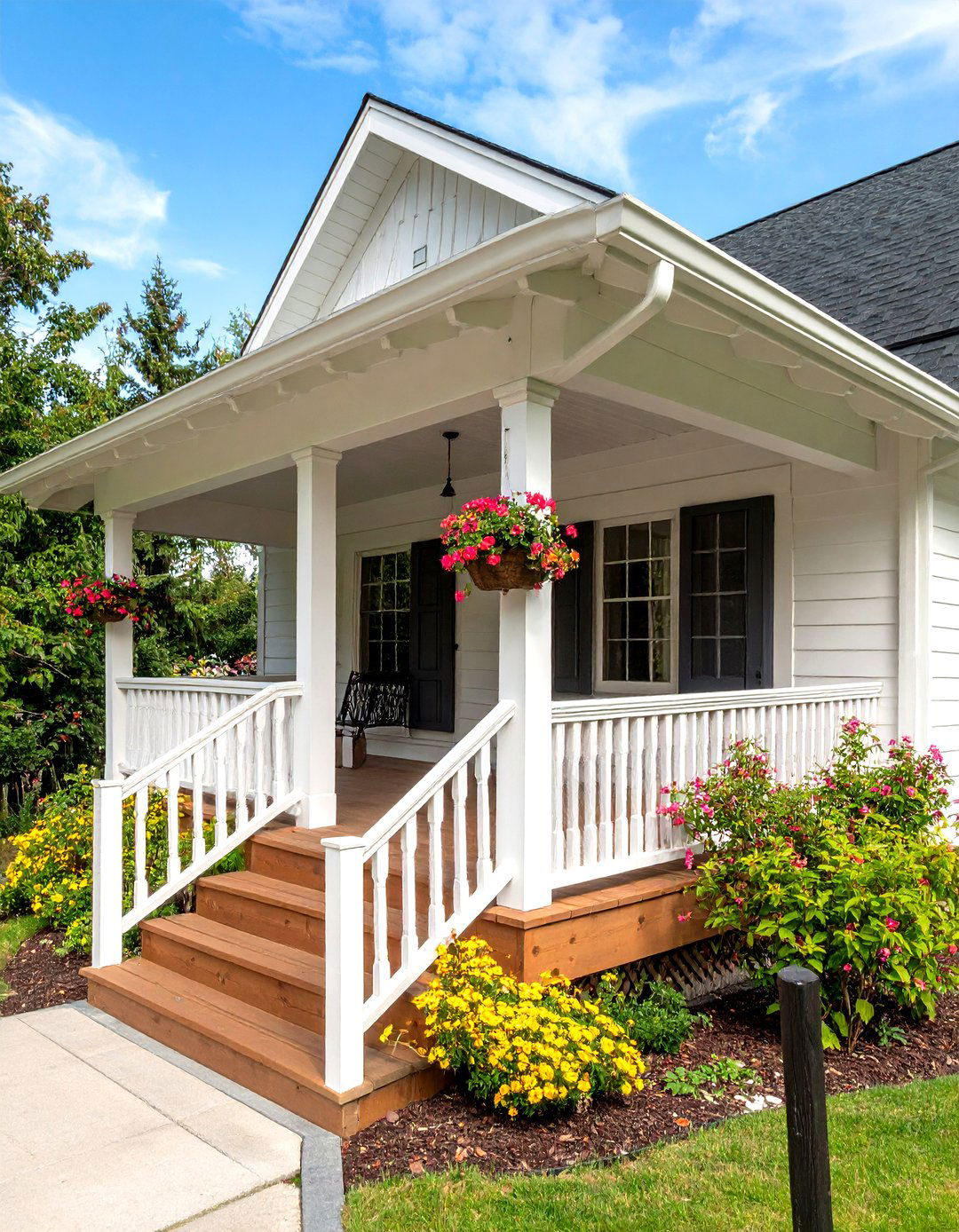
Take living space around the corner with a wrap-around front porch roof that follows two or more elevations, perfect for farmhouses or lake cottages that chase evening breezes. Match the fascia height to existing eaves for a seamless merge, and frame inside corners with 45-degree “rain porch” returns to push water clear of foot traffic. Continuous decking boards and a perimeter handrail help the roof read as one cohesive gesture, even if you phase construction over several seasons.
15. Retractable Canopy Porch Roof
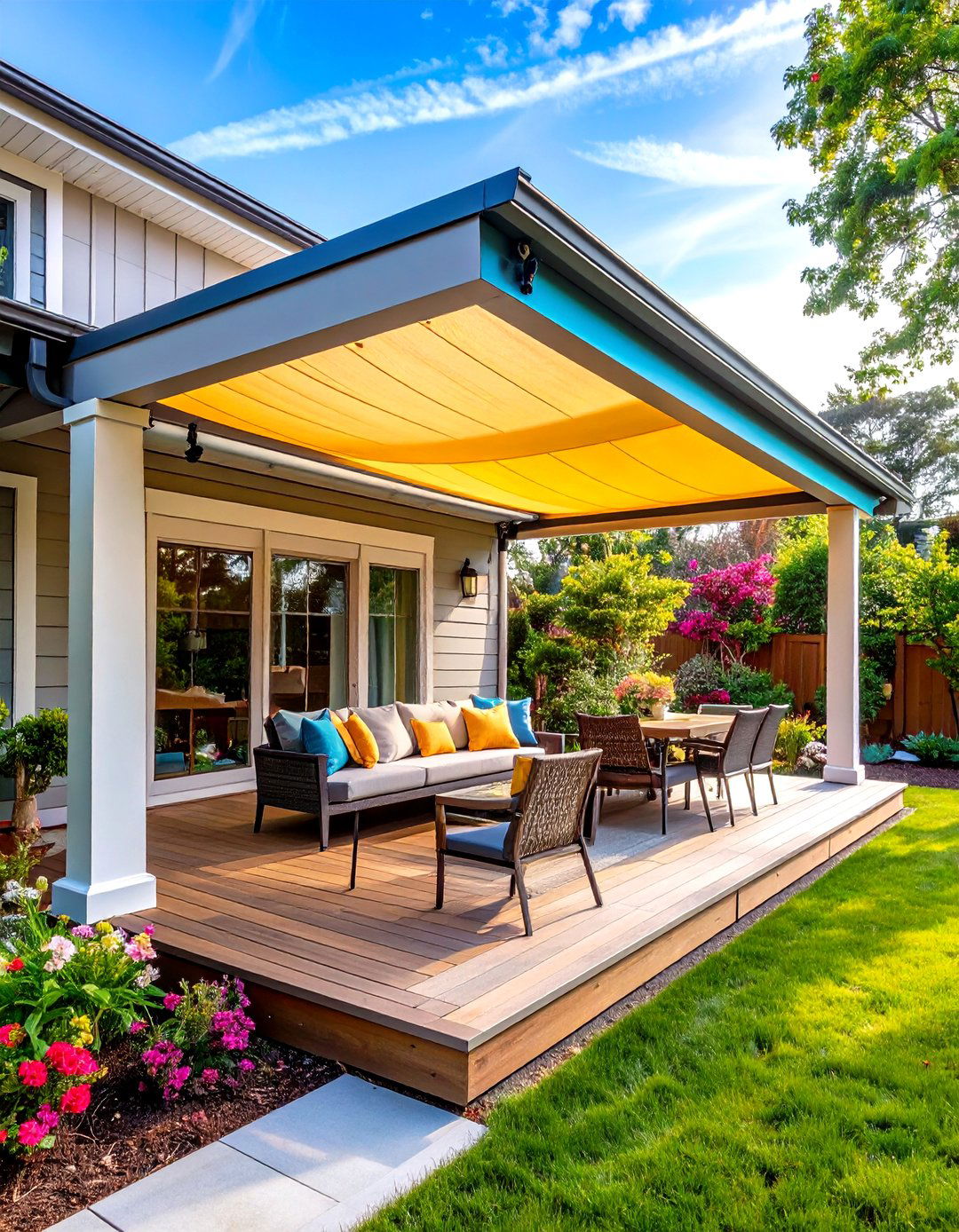
For maximum flexibility, a retractable canopy front porch roof slides open on aluminum tracks when you crave sun, then closes tight for downpours. Commercial pergola systems withstand 60-mph gusts and heavy rain loads thanks to integrated gutters at each rail. Choose UV-stable acrylic fabric in a house-body accent color, and add a wind sensor that auto-closes the canopy if breezes pick up while you’re away. Because tracks bolt to existing rafters, most installs finish in a weekend without disturbing roofing above.
16. Solar-Louvered Porch Roof
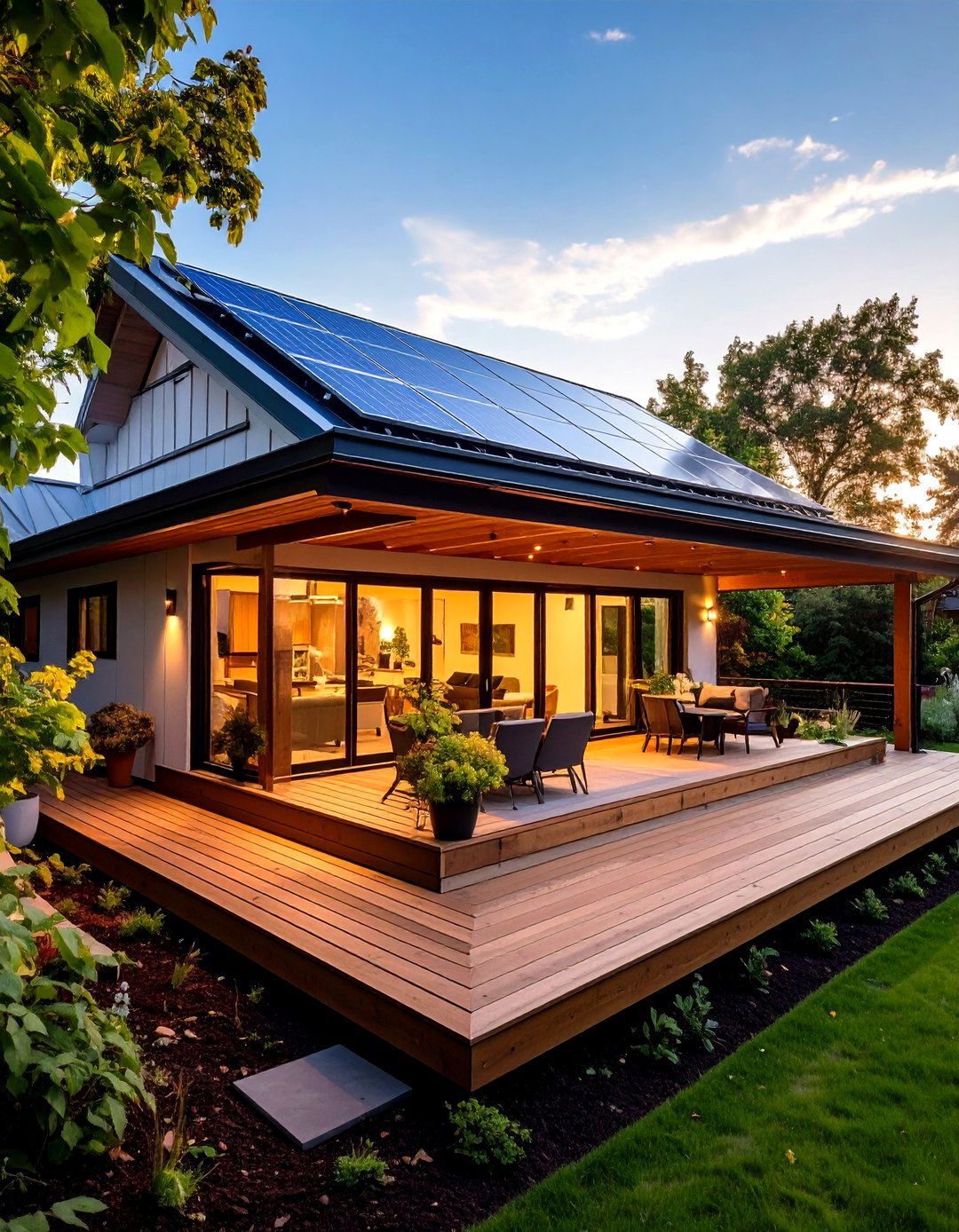
Turn structure into a power plant by installing a solar-louvered front porch roof whose adjustable aluminum slats hide photovoltaic cells. Each square meter can generate roughly 80 watts—enough to run integrated LED downlights, phone chargers, or even backyard speakers. Position the louvers true south (or north in the Southern Hemisphere) and tilt between 15 ° and 30 ° for peak harvest. Low-voltage wiring stays inside hollow mullions, leaving the ceiling uncluttered, and surplus power can back-feed a micro-inverter for household use.
17. Rustic Tin Porch Roof

Sometimes patina is the point: a rustic tin front porch roof combines corrugated galvanized panels with reclaimed-wood beams for farmhouse soul. Bob Vila praises tin for the nostalgic “rain-on-the-roof” soundtrack and light 0.5-lb-per-sq. ft. weight that minimizes added load. Spray-foam or add a radiant-barrier underlayment to curb summertime heat gain, and finish exposed fasteners with neoprene washers to prevent rusty drips down freshly painted columns.
18. Barrel-Vaulted Porch Roof
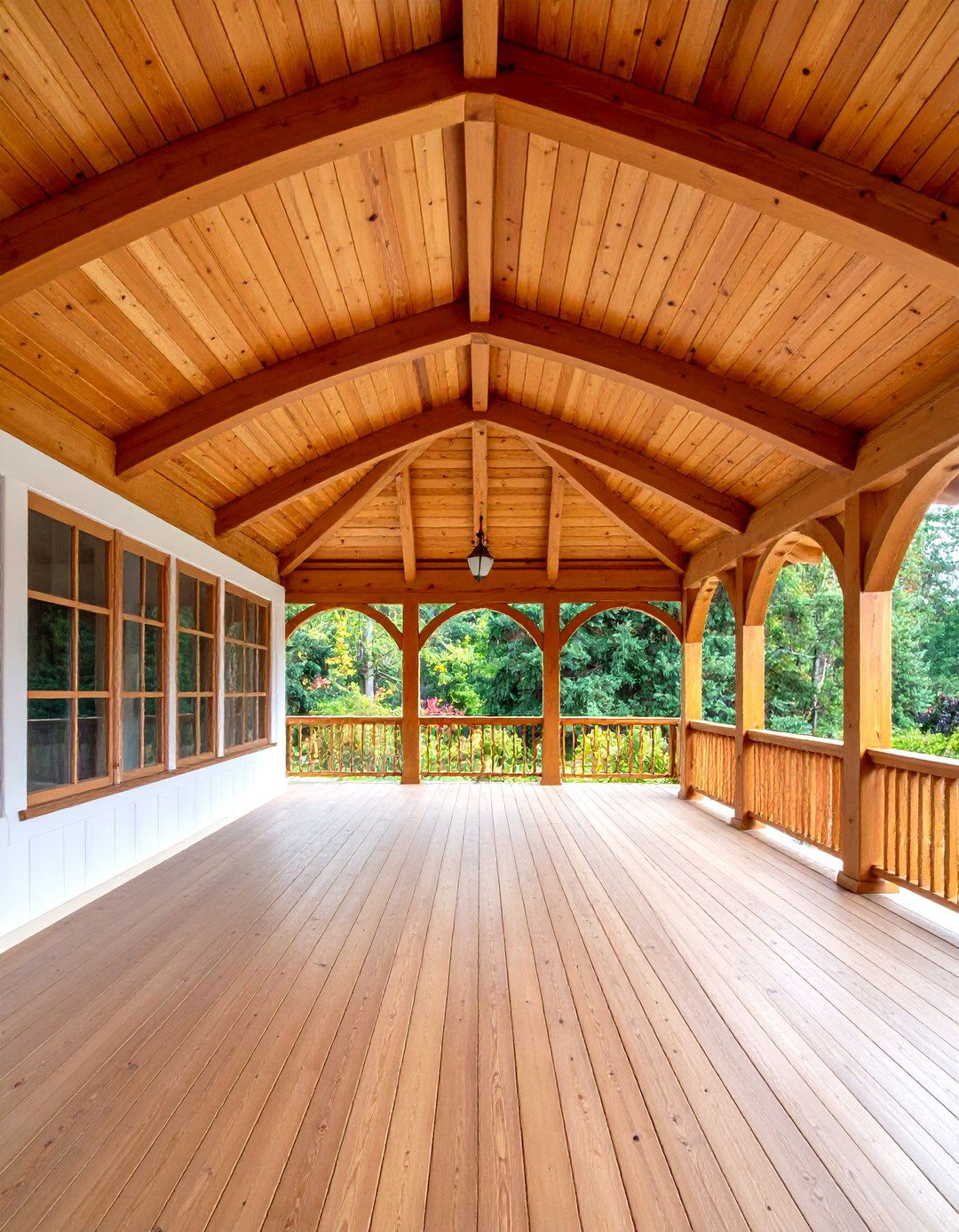
Where symmetry meets craftsmanship, a barrel-vaulted front porch roof turns basic stoops into grand entries. Laminated ribs arch over a rectangular plan, eliminating ponding common on low-pitch curves. Use beadboard or cedar strips bent edge-to-edge for the ceiling skin, and flank the arch with half-round sidelights for borrowed light. Because curved rafters concentrate thrust, anchor wall plates with structural screws into double top plates or retrofit steel straps.
19. Timber-Frame Cathedral Porch Roof
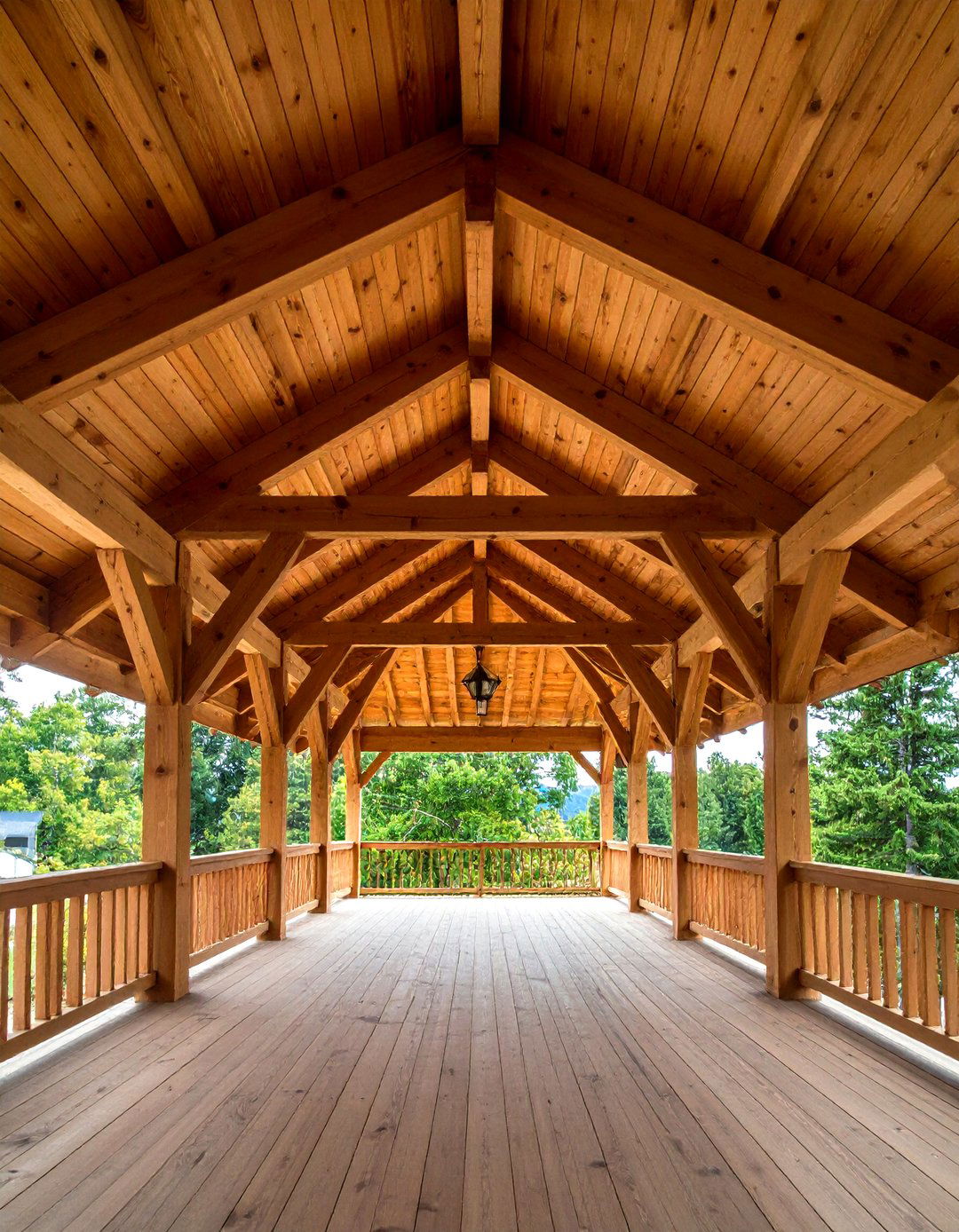
For lodge-like gravitas, a timber-frame cathedral front porch roof soars upward on exposed trusses and pegged mortise-and-tenon joinery. Full-dimension 8×8 or 10×10 timbers carry long spans, allowing wide staircases and stone piers below. Apply a clear hard-wax oil to showcase grain, and install concealed cable braces behind king-posts if seismic or snow loads warrant extra resistance. A tongue-and-groove cedar ceiling laid perpendicular to the ridge accentuates height while hiding electrical conduit for chandeliers.
20. Contemporary Flat Overhang Porch Roof
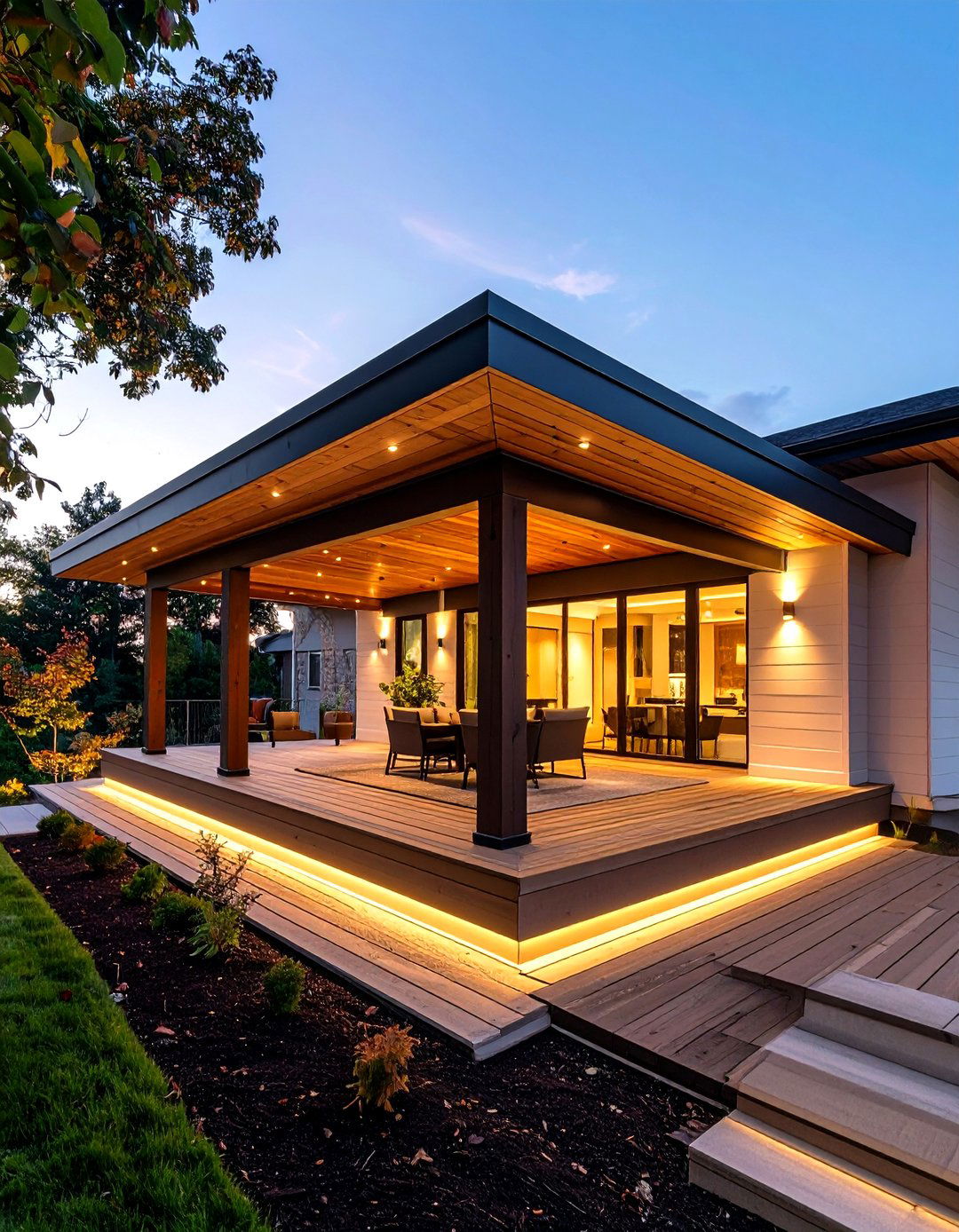
Finally, a contemporary flat-overhang front porch roof embraces minimalist lines yet quietly shields doors and siding from weather. Deep eaves reduce splashback and solar gain, helping paint last longer and cooling costs drop. Frame with tapered furring strips so water pitches ¼-inch per foot toward an internal gutter, and detail the fascia in color-matched aluminum for a razor-thin edge. LED strip lighting hidden behind the drip-edge provides a welcoming glow that never reveals its source.
Conclusion:
Selecting the best front porch roof means weighing climate, maintenance tolerance, and architectural character rather than defaulting to the builder’s stock plan. From wind-taming hip roofs to power-generating solar louvers, each idea above solves a specific challenge while amplifying curb appeal. Combine profiles—like a metal-clad shed with deep overhangs—or add smart tech such as retractable canopies to customize comfort year-round. Work with licensed pros for load calculations, follow local codes for snow and uplift, and your chosen porch roof will reward you daily with protection, energy savings, and an unmistakably welcoming first impression.


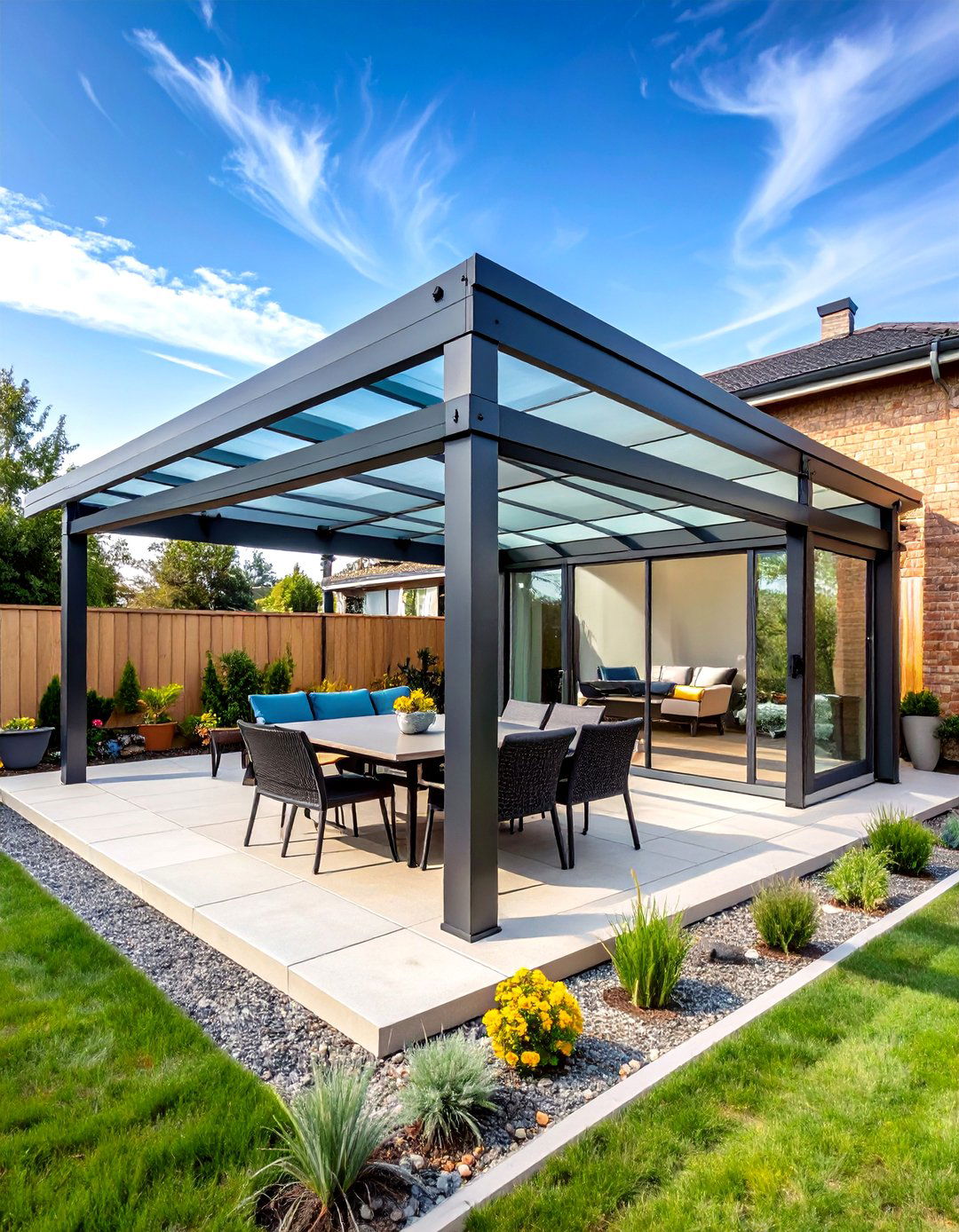
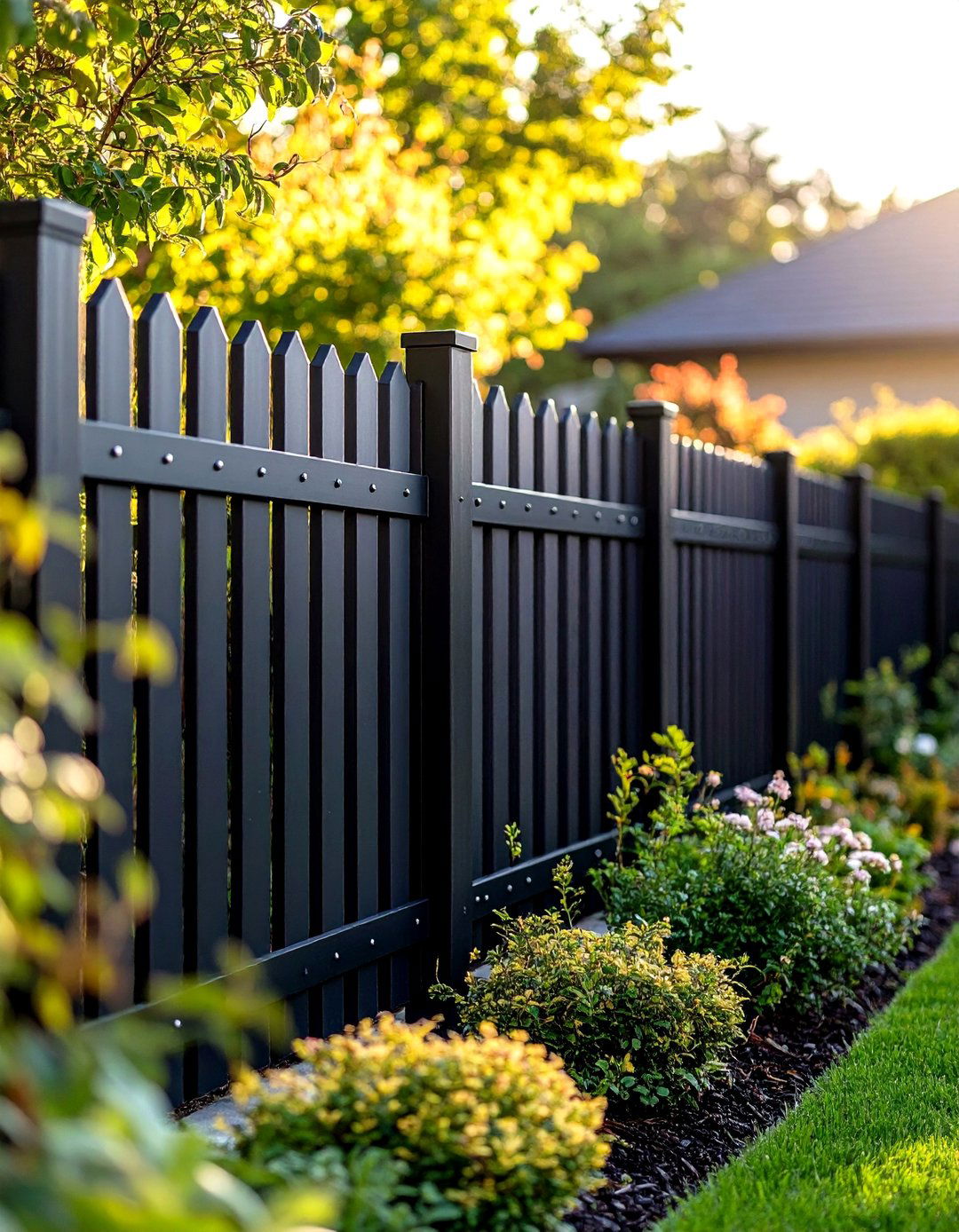

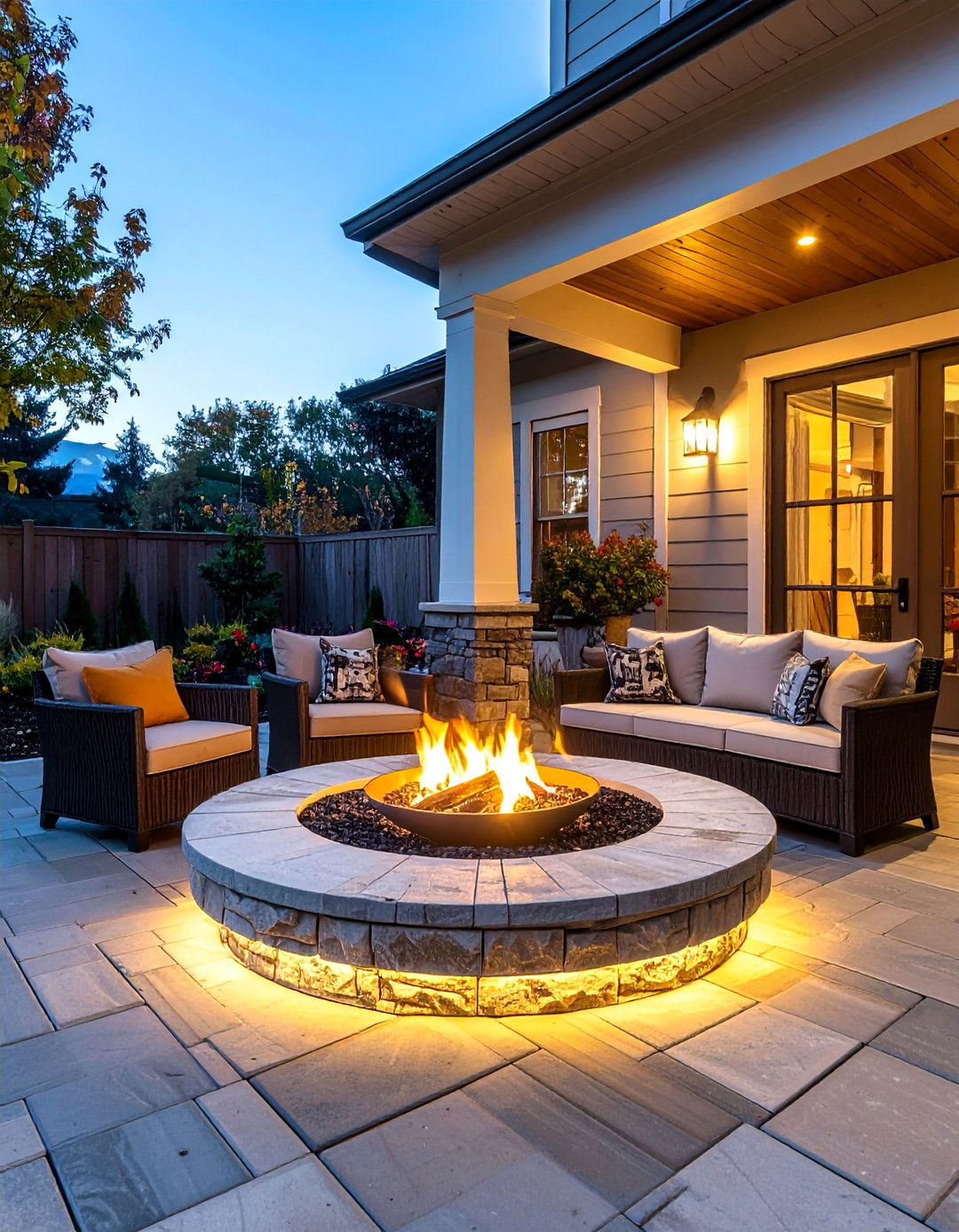
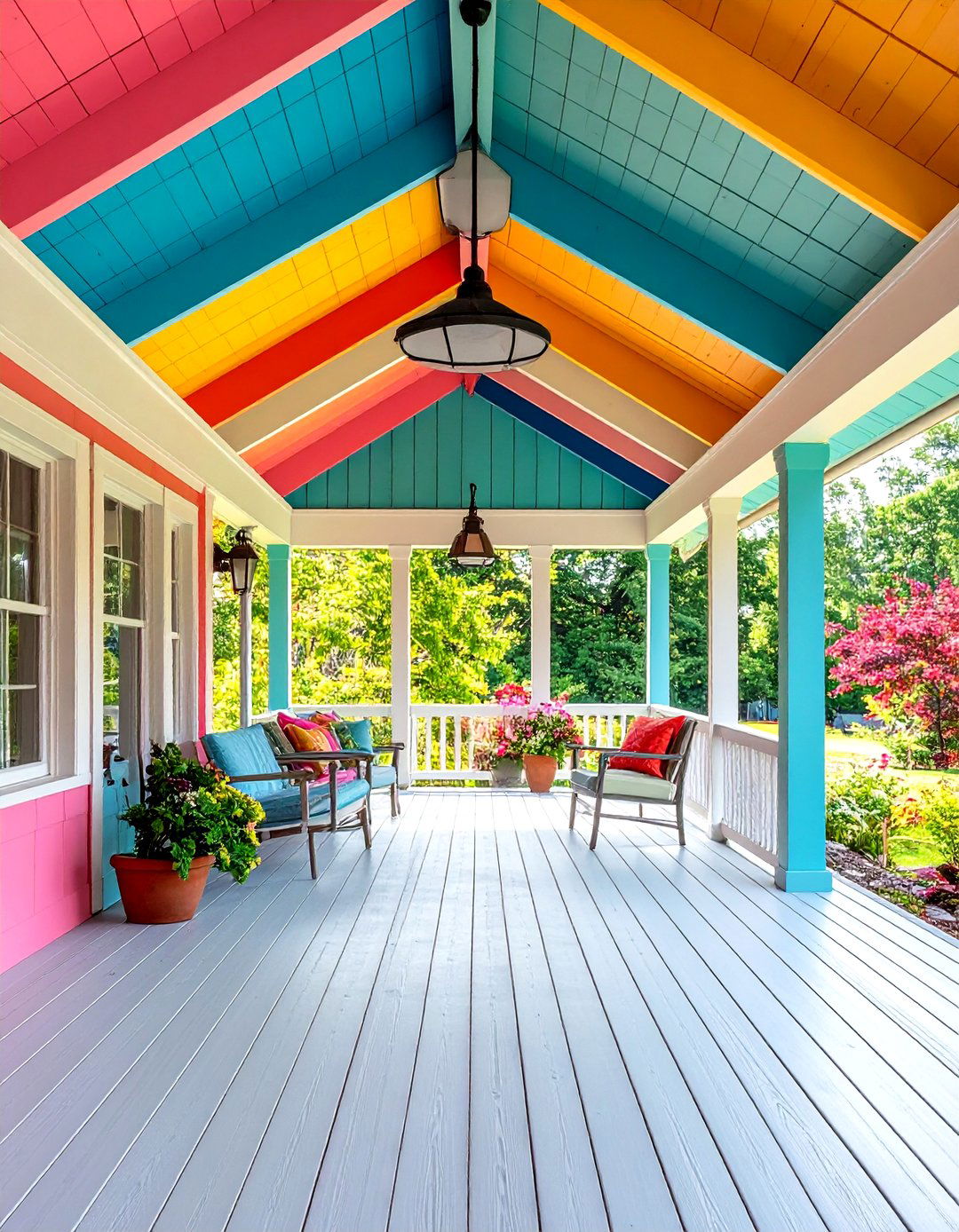
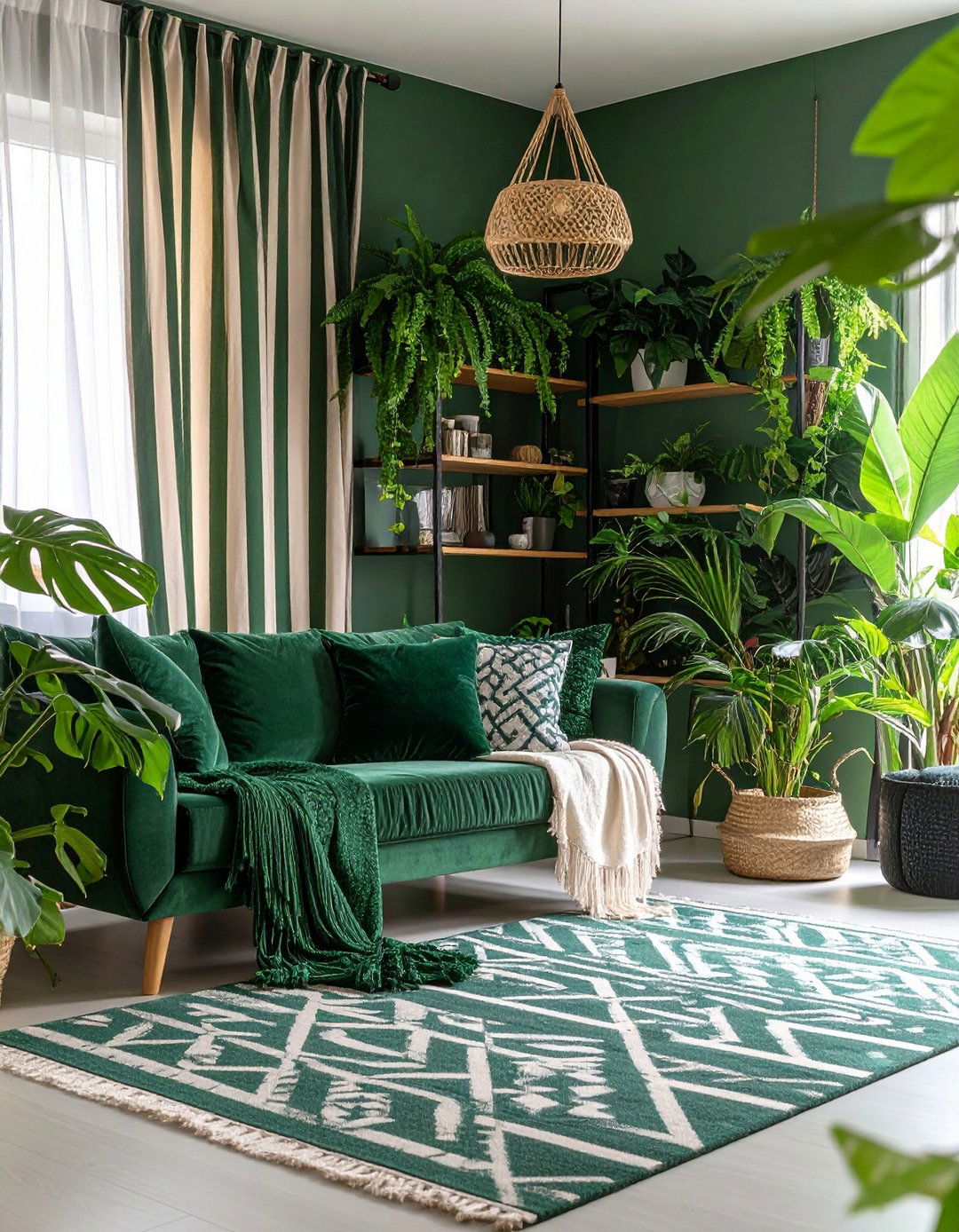


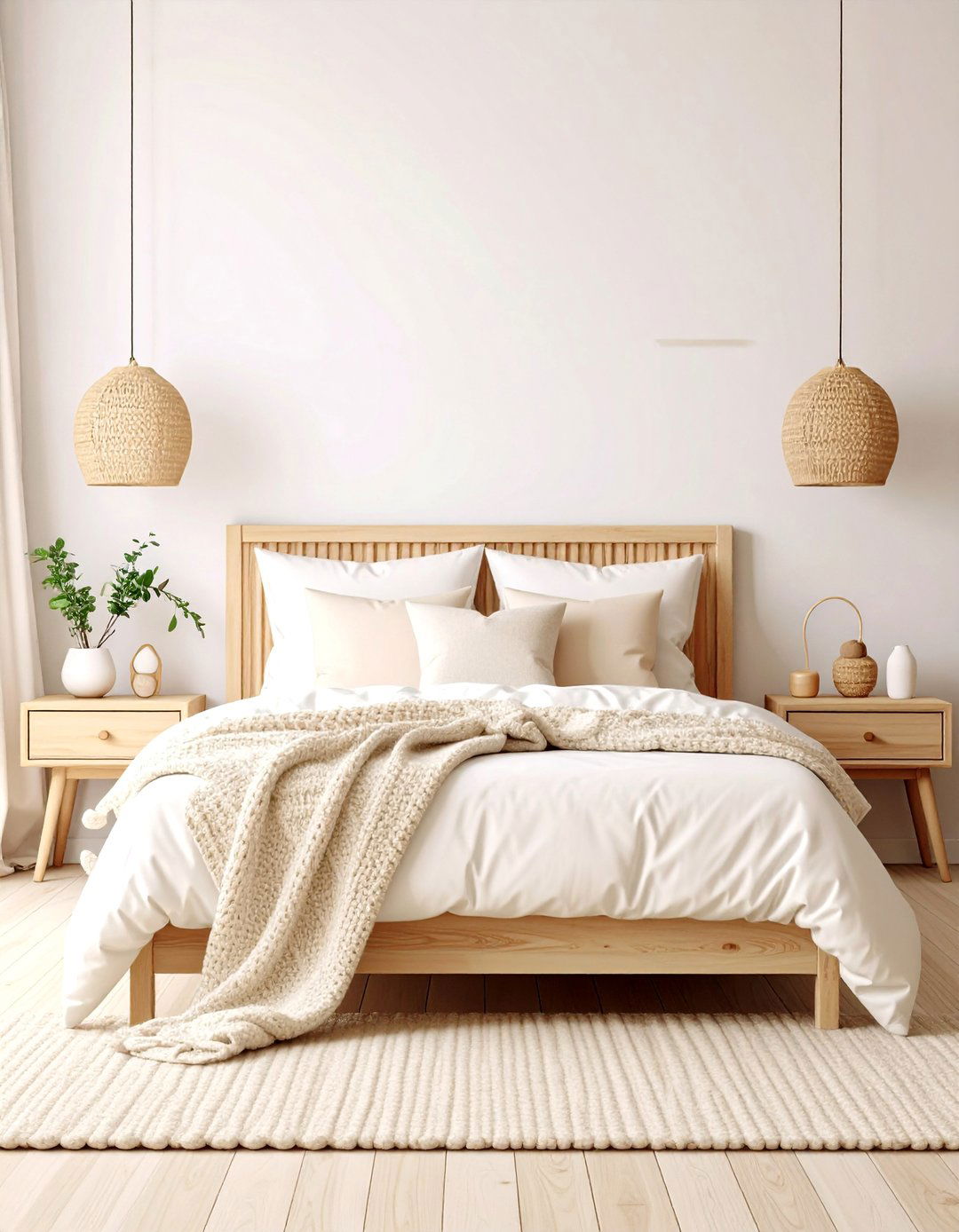
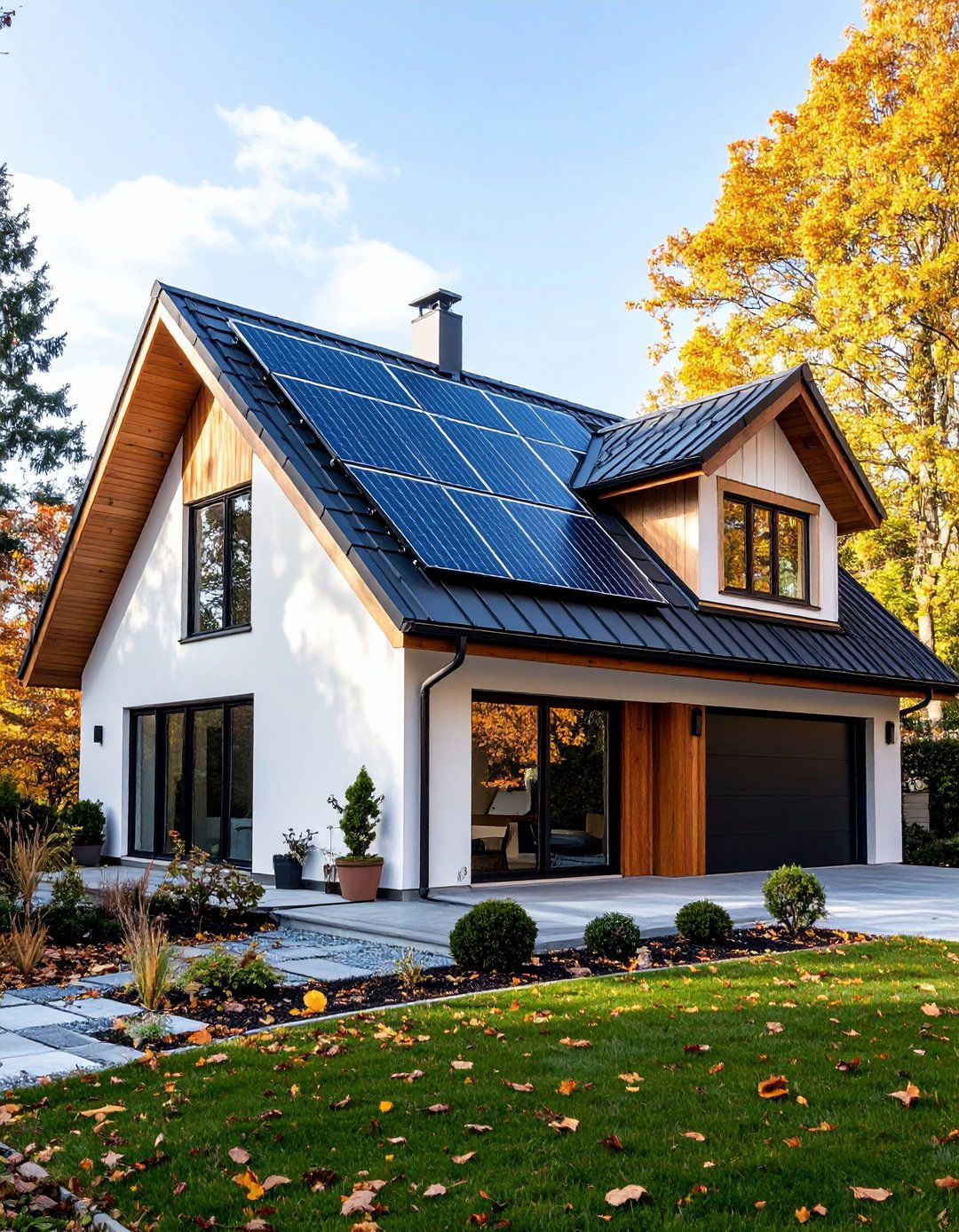
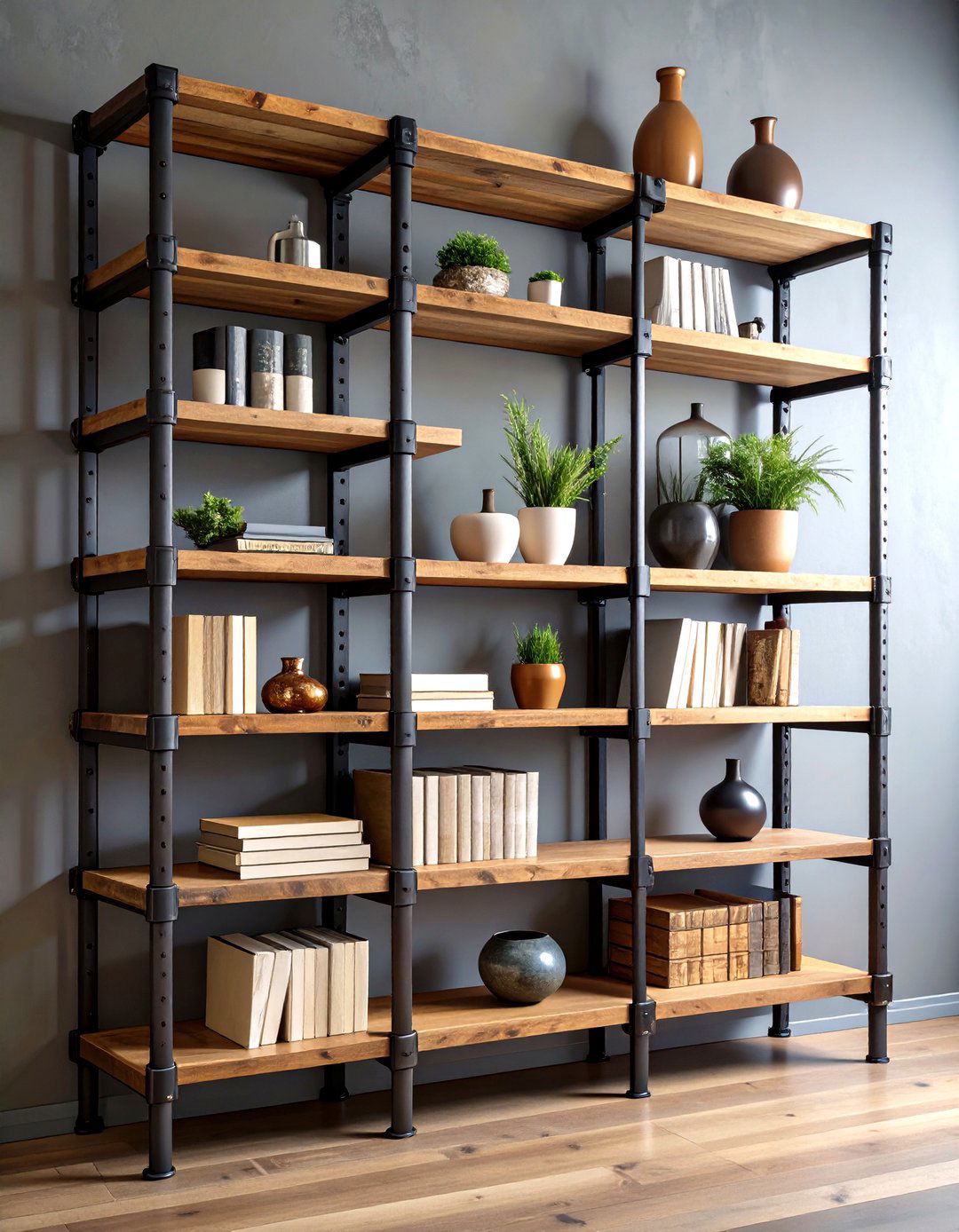

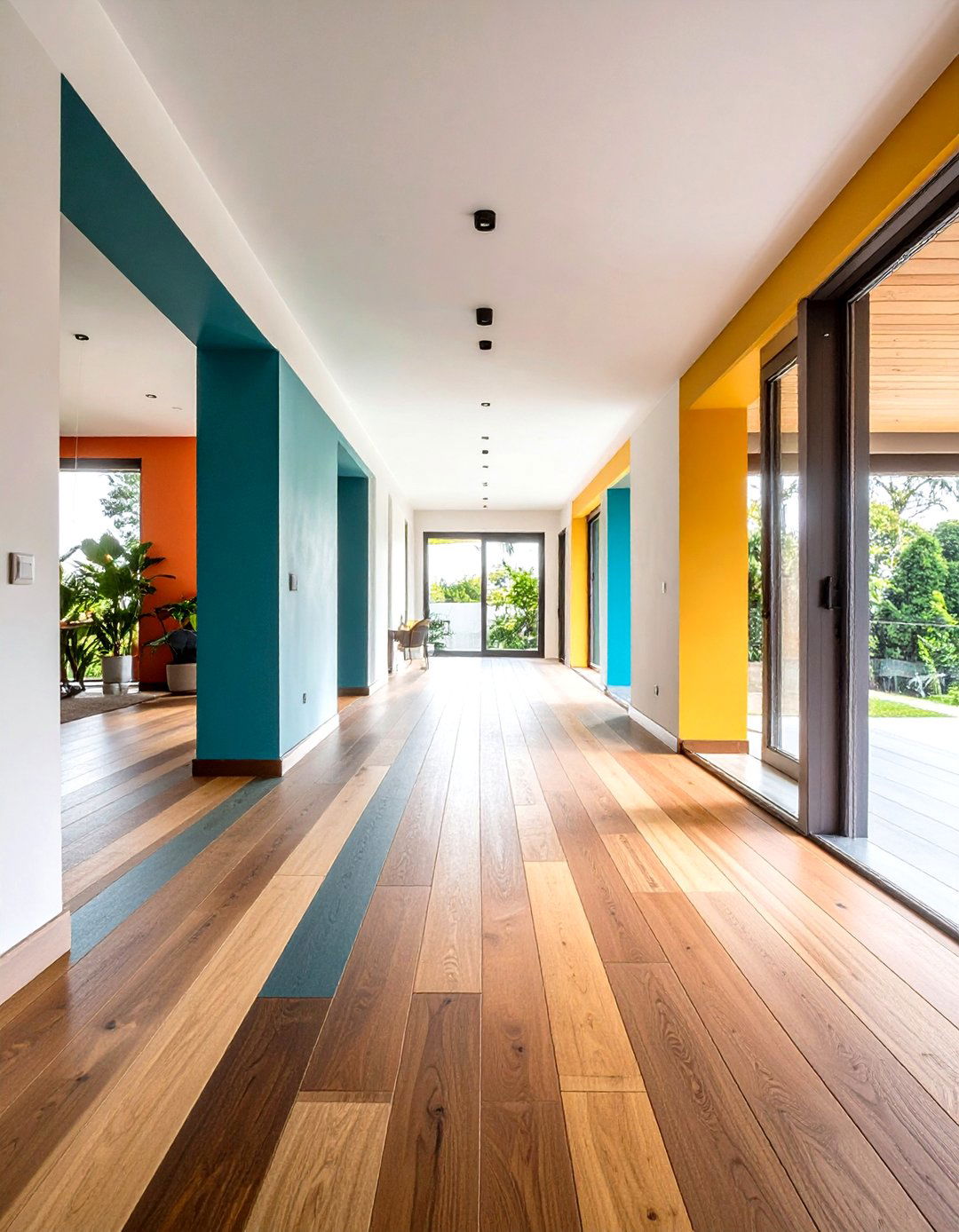
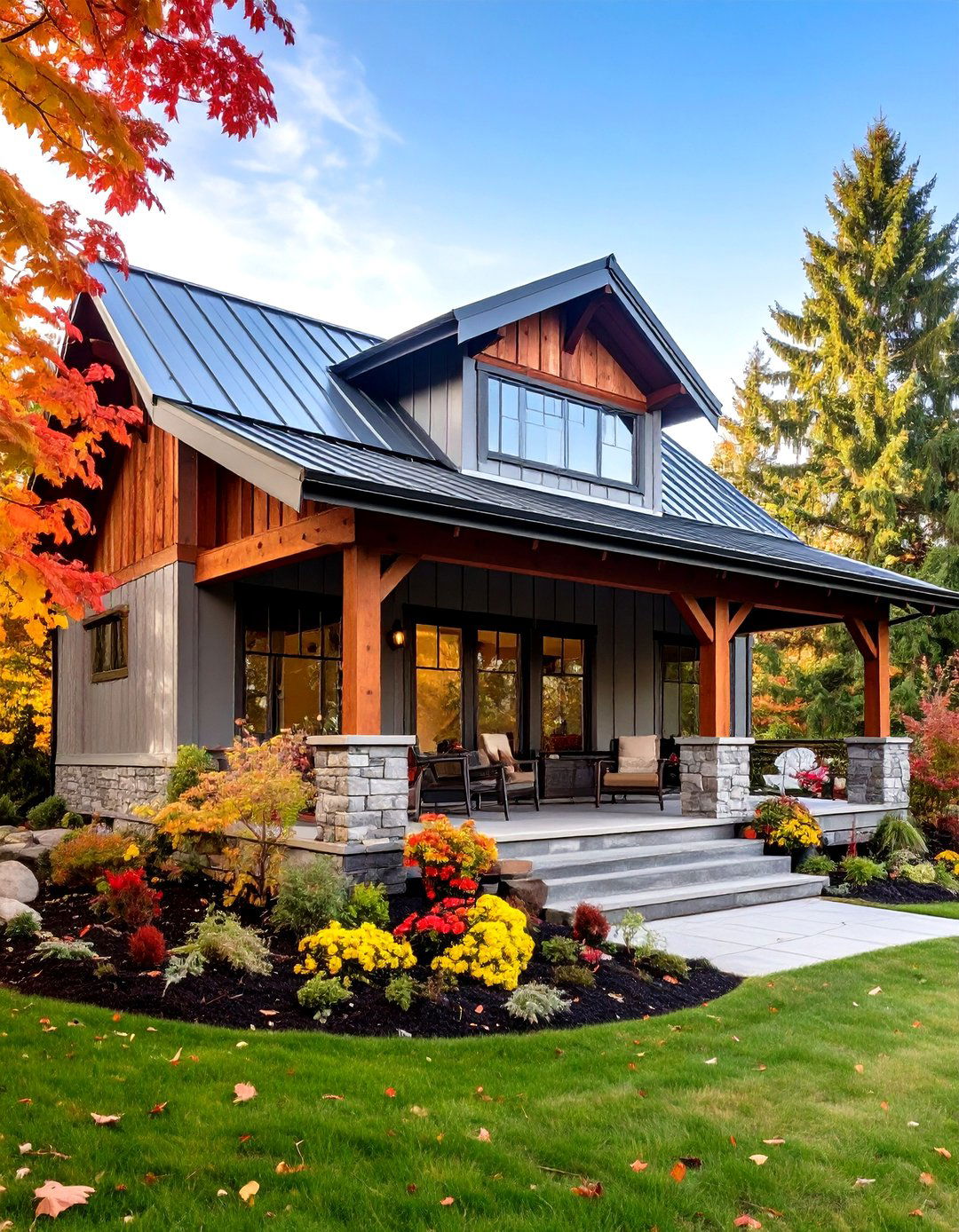
Leave a Reply